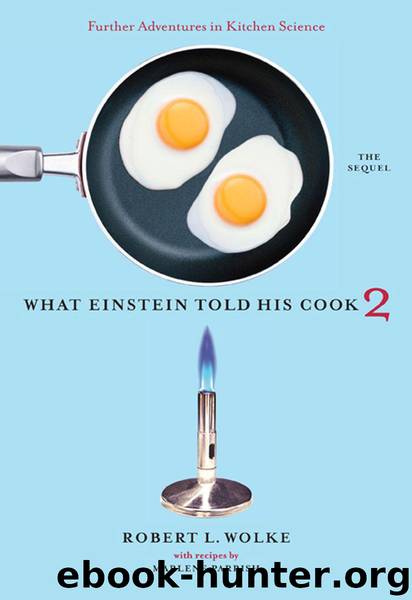What Einstein Told His Cook 2: The Sequel: Further Adventures in Kitchen Science: The Sequel v. 2 by Wolke Robert L. & Parrish Marlene

Author:Wolke, Robert L. & Parrish, Marlene [Wolke, Robert L.]
Language: eng
Format: mobi
Publisher: W. W. Norton & Company
Published: 2011-01-11T16:00:00+00:00
* * *
THE FOODIE’S FICTIONARY: Al dente—an Italian fender bender
* * *
* * *
THE FOODIE’S FICTIONARY: Rigoletto—a type of pasta
* * *
PLEASE DON’T EAT THE MATTRESS
If I make a smoothie by blending fruit with milk, yogurt, or whatever, are the positive effects of the fiber eliminated by processing the fruit in a blender?
No. No matter how thoroughly pureed it is, the fiber is still effective.
In the dietary context, the word fiber is misleading because it conjures up images of eating coconut husks and mattress stuffing. But dietary fiber doesn’t refer to a physical texture. It’s a catchall term for the components of vegetable foods that humans don’t have the enzymes for digesting, and that therefore have no energy value and pass through our digestive tracts unchanged (which is their major virtue). We used to call it bulk or roughage. Although it has no chemical or nutritive value, it is essential for physically moving everything we eat through the processing plant we call the alimentary canal.
Dietary fiber, found in fruits, vegetables, and grains but not in animal products, has been found to decrease the risk of certain disorders such as colon cancer, although that finding has been challenged. Nevertheless, fiber is one of the main reasons that eating fruits and vegetables is so important to health.
There are both water-soluble and water-insoluble fiber substances, and nutritionists recommend eating lots of both kinds. The soluble ones are mostly pectins and gums, found in fruits; they’re what cause fruit jellies to gel. Tart apples, crab apples, sour plums, Concord grapes, quinces, gooseberries, red currants, and cranberries are especially high in pectin. The most common insoluble fibers are cellulose and lignin, the binder between the cellulose fibers that make up the structural framework of plants’ cell walls.
Some termites can digest and utilize the energy inherent in cellulose and lignin, but we humans can’t. On the other hand, termites are lousy at Scrabble.
Download
This site does not store any files on its server. We only index and link to content provided by other sites. Please contact the content providers to delete copyright contents if any and email us, we'll remove relevant links or contents immediately.
A Court of Wings and Ruin by Sarah J. Maas(7651)
The Death of the Heart by Elizabeth Bowen(3552)
The Sprouting Book by Ann Wigmore(3543)
Better Homes and Gardens New Cookbook by Better Homes & Gardens(3525)
BraveTart by Stella Parks(3395)
Salt, Fat, Acid, Heat: Mastering the Elements of Good Cooking by Nosrat Samin(3108)
Sauces by James Peterson(3051)
Kitchen confidential by Anthony Bourdain(3009)
The Bread Bible by Rose Levy Beranbaum(3004)
Classic by Mary Berry(2942)
Solo Food by Janneke Vreugdenhil(2929)
Ottolenghi - The Cookbook by Yotam Ottolenghi(2871)
Martha Stewart's Baking Handbook by Martha Stewart(2796)
Day by Elie Wiesel(2720)
Betty Crocker's Good and Easy Cook Book by Betty Crocker(2681)
The Plant Paradox by Dr. Steven R. Gundry M.D(2547)
My Pantry by Alice Waters(2546)
The Kitchen Counter Cooking School by Kathleen Flinn(2486)
Hot Sauce Nation by Denver Nicks(2451)
